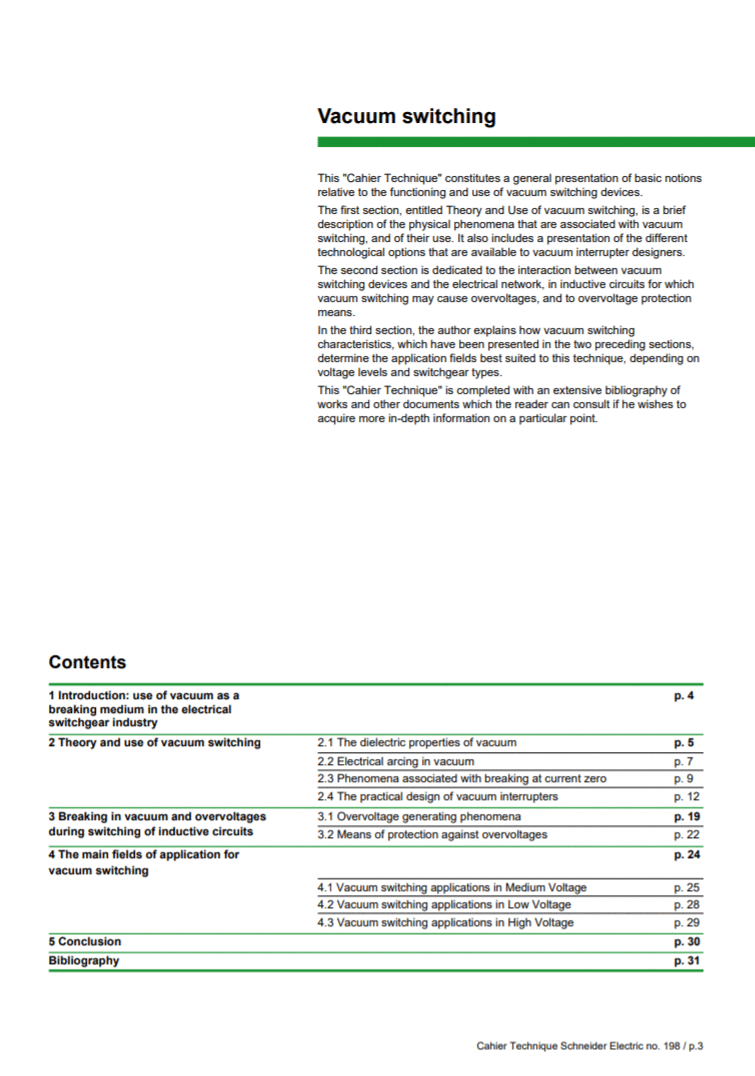Physical phenomena
This “Cahier Technique” constitutes a general presentation of basic notions relative to the functioning and use of vacuum switching devices. The first section, entitled Theory and Use of vacuum switching, is a brief description of the physical phenomena that are associated with vacuum switching, and of their use. It also includes a presentation of the different technological options that are available to vacuum interrupter designers.

The second section is dedicated to the interaction between vacuum switching devices and the electrical network, in inductive circuits for which vacuum switching may cause overvoltages, and to overvoltage protection means.
In the third section, the author explains how vacuum switching characteristics, which have been presented in the two preceding sections, determine the application fields best suited to this technique, depending on voltage levels and switchgear types.
This “Cahier Technique” is completed with an extensive bibliography of works and other documents which the reader can consult if he wishes to acquire more in-depth information on a particular point.
Use of vacuum as a breaking medium in the electrical switchgear
SF6 and vacuum are the two most modern breaking techniques in the fields of Medium Voltage (from 1 to 52 kV) and High Voltage (> 72.5 kV). They appeared in the 1960’s and rapidly developed as of the 1970’s. Today they have replaced the former air and oil breaking techniques (see fig. 1 ).
Whereas SF6 is used in all of the medium voltage and high voltage ranges, vacuum has primarily developed in the medium voltage field, with limited incursions in low voltage and in high voltage: the two techniques only compete with each other in the medium voltage field.
This notion of rivalry between the two techniques is now in fact out of date: even if at some time there was commercial competition between manufacturers that opted for one or the other of these techniques, today all large-scale manufacturers offer both techniques so as to be able to satisfy as best as possible their client’s needs. Indeed, each technique has its strong points and its weak points. Even if each is highly multi-functional and can offer a reliable and competitive solution for most medium voltage interruption problems, users want to be able to choose for themselves in function of their applications, operation and maintenance policies, priorities … and of course habits!
In the past, the vacuum switching technique was first developed by American and English manufacturers (the pioneers were General Electric and VIL), followed by the Japanese and the Germans: these countries have the common feature of using networks with relatively low voltage ratings (from 7.2 to 15 kV) for medium voltage electrical energy distribution. However, in countries like France and Italy which distribute electricity with voltage levels near 24 kV, manufacturers opted for the SF6 breaking technique.
It is remarkable to note, 30 years later, the appropriateness of these technological choices in regard to the foreseen application. In fact still today, a global technical-financial evaluation of both techniques shows an equivalence when using voltages between 12 and 24 kV, with a relative advantage for SF6 above this voltage level, and for vacuum below this level. However, the difference in cost remains low, which explains how the two offers, vacuum and SF6, can coexist, for all medium voltage levels from 7.2 to 36 kV.
AUTHOR: Schneider Electric expert | Philippe PICOT
| Title: | Vacuum switching |
| Format: | |
| Size: | 1.1MB |
| Pages: | 36 |
| Download: | Right here | Video Courses | Membership | Download Updates |


